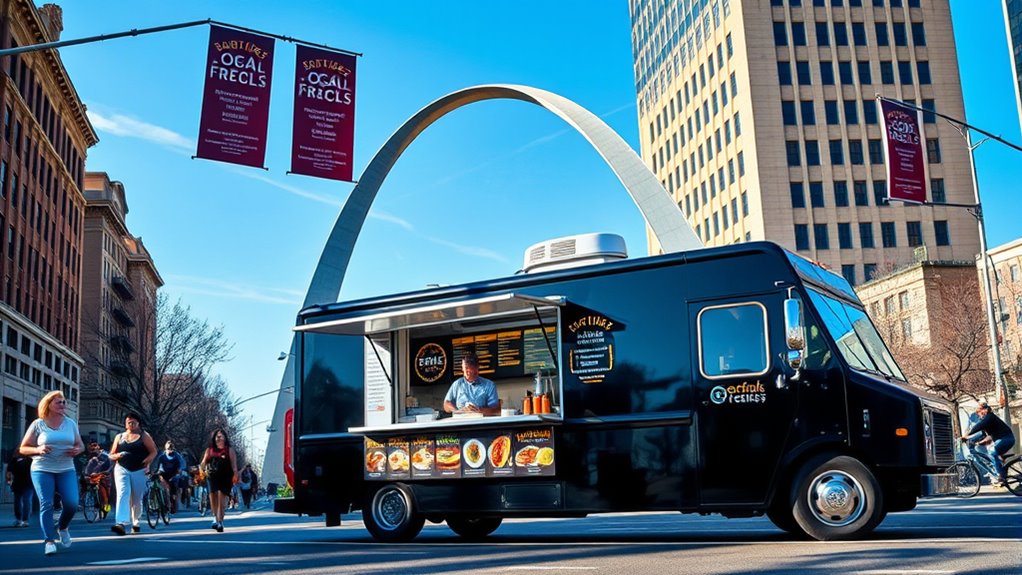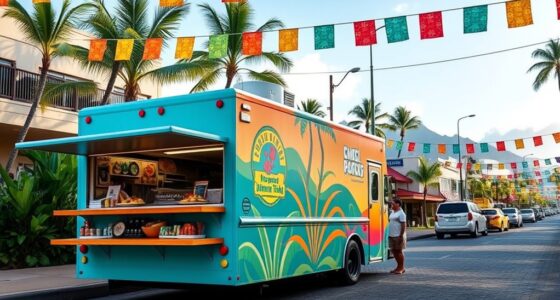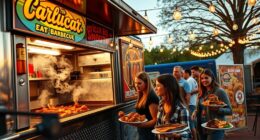To start your food truck in St. Louis, you need to secure permits from the Department of Public Safety, pass health and fire safety inspections, and guarantee your truck meets sanitation standards. Budget around $500 annually for permits, plus costs for equipment, insurance, and startup expenses. Choose locations carefully, avoiding restricted zones near schools or residences. Designing a simple, flavorful menu and using social media will boost your visibility. If you keep going, you’ll find helpful tips to get started smoothly.
Key Takeaways
- Obtain necessary permits from the St. Louis Department of Public Safety, including food truck, health, and fire safety certifications.
- Budget between $30,000–$180,000 for truck purchase and setup, plus annual costs for permits, insurance, and maintenance.
- Choose strategic locations compliant with zoning laws, avoiding restricted zones near schools and residential areas.
- Design a simple, local-flavor menu with 8–15 handheld items focusing on speed and ingredient overlap for efficiency.
- Promote via social media, participate in local events, and build community relationships to increase visibility and customer loyalty.

Handling permits and licensing in St. Louis is a vital step before hitting the streets. You need to apply for a Mobile Food Vending Permit through the Department of Public Safety, either on the city website or permit portal. Your application must include a completed Food Truck Permit form and payment of applicable fees. To get approved, you’ll need to pass health and fire safety inspections conducted by the City Health Department and Building Division, respectively. Be prepared to show proof of a business or vending license and fire safety certification. Additionally, you’ll need to complete a Food Protection Manager Certification. Make sure your truck meets sanitation standards, including a handwashing station, and display all permits prominently during operation. The permitting process also involves compliance with local zoning laws, such as maintaining minimum distances from schools and residential areas. This process guarantees you’re fully compliant before serving your first customer.
Ensuring Food Safety and Health Compliance

After securing your permits and passing initial inspections, maintaining food safety and health compliance becomes your top priority. You need to follow local health department regulations to prevent hazards and ensure safe food handling. Here are three essential steps:
- Regular Inspections: Pass health department inspections and adhere to Missouri Food Code requirements. Be prepared for additional local mandates for mobile units. Inspections are scheduled through the city’s system and require an appointment, which can only be rescheduled once.
- Proper Handling and Storage: Maintain correct cooking temperatures, keep foods covered during transport, and use refrigerated or insulated containers to prevent contamination.
- Employee Hygiene: Train staff on proper handwashing, illness restrictions, and personal hygiene standards. Enforce policies to minimize risks of foodborne illnesses.
Staying compliant guarantees customer safety, avoids penalties, and helps your food truck operate smoothly. [Food safety equipment, like ABC type fire extinguishers, is required for safety compliance, and regular maintenance checks should be part of your routine.
Understanding Costs for Starting Your Food Truck
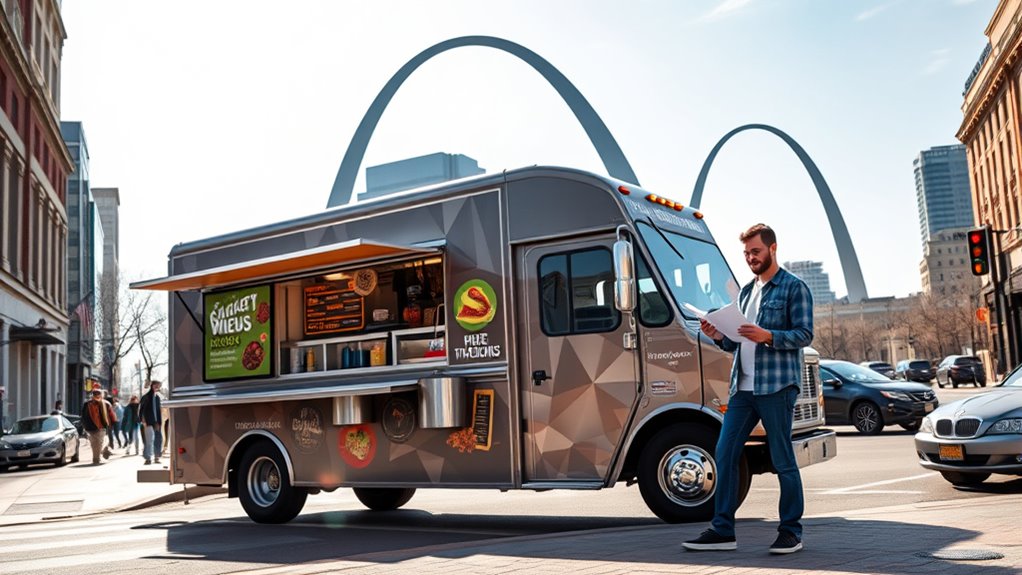
Starting your food truck requires a clear understanding of the costs involved, from purchasing and outfitting the vehicle to securing necessary permits and ongoing expenses. A new, fully equipped truck in Missouri can cost between $90,000 and $180,000, while used options start around $30,000 but may need retrofitting. Initial inventory typically costs $2,000 to $3,000. Permits, including a Mobile Food Vending Permit in St. Louis, cost about $500 annually, plus fees for licenses and insurance. Expect annual maintenance of $500 to $1,200, and fuel expenses around $500 to $1,000 yearly. Additional startup costs, such as marketing, signage, and equipment, can range from $5,000 to $20,000. Budget for ongoing supplies, permit renewals, and promotional activities to keep your food truck business running smoothly. Operating expenses also include vehicle insurance, which generally costs $2,000 to $4,000 annually in Missouri.
Zoning Rules and Optimal Operating Locations
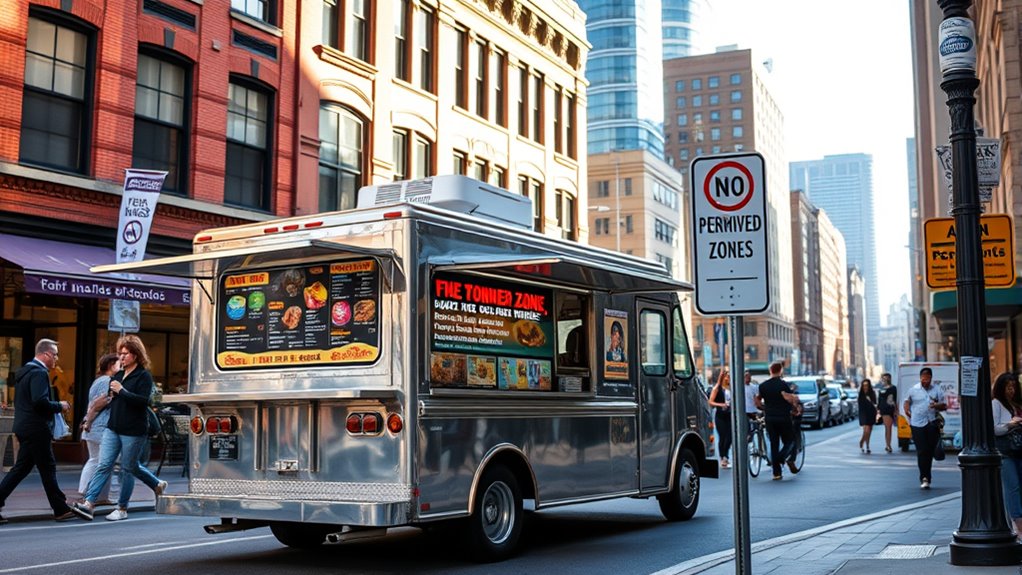
In St. Louis, zoning rules shape where you can operate your food truck. First, you must obtain a permit and verify your truck is within approved zones, including public streets, parks, and private properties with owner permission. Second, avoid operating within 200 feet of schools to protect students. Third, if you want to vend at special events, secure temporary permits ahead of time, as regulations vary. For ideal locations, focus on downtown vending zones with high foot traffic, near office buildings, entertainment districts, and business hubs. Private property vending is an option if you get property owner approval. Remember, you can’t block loading zones, fire hydrants, or create traffic hazards, so parking and location choices must adhere to city ordinances. Additionally, permanent food truck registration and permits are essential before starting operations, ensuring compliance with local safety and licensing requirements.
Designing a Menu for Mobile Success
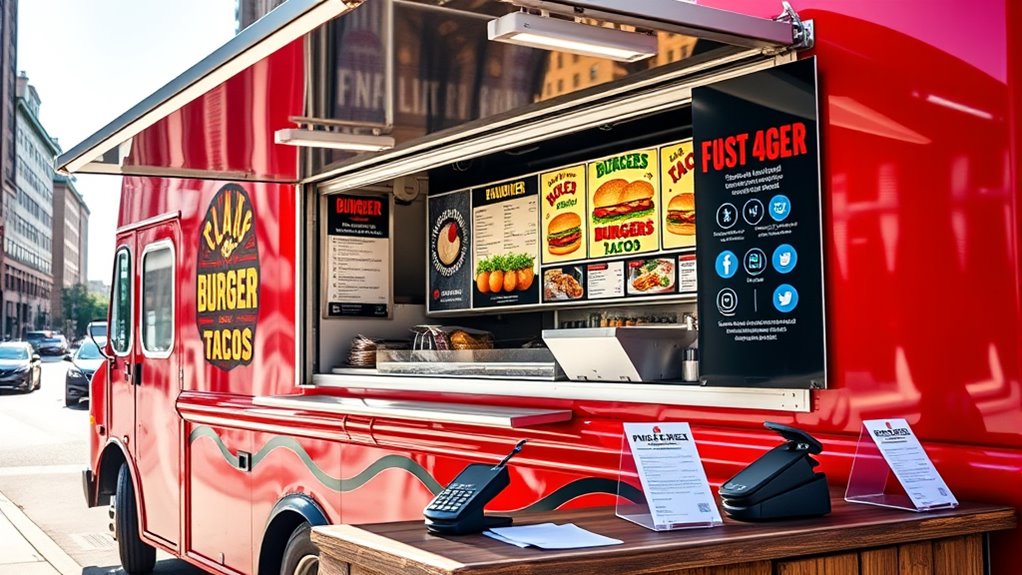
When designing your menu, focus on handheld items that are easy to eat on the go and quick to prepare. Prioritize local flavors to stand out and connect with the community, making your truck more memorable. Keep your processes simple to guarantee fast service and a smooth customer experience. Conduct market research by visiting local food markets and observing popular stalls with long lines to identify trending menu items. Incorporating Pimple Patch options or other innovative products can also attract curious customers seeking quick solutions to skin concerns.
Focus on Handheld Items
Designing a successful handheld menu for a food truck means focusing on a concise, well-curated selection of 8 to 15 items that are quick to prepare and easy to eat on the go. To maximize efficiency and customer satisfaction, consider these key points:
- Select dishes that are easy to eat by hand, avoiding cutlery and emphasizing portability.
- Use ingredient overlap across items to streamline prep, reduce waste, and ensure quick service.
- Highlight signature or unique handheld options to strengthen your brand identity and boost recall.
- Research customer preferences to ensure your menu aligns with local tastes and dietary trends, increasing the likelihood of repeat business.
- Incorporate visual appeal in your menu design to attract attention and make your offerings more enticing.
Arrange your menu with visibility in mind, placing high-profit and signature items where they catch the eye. Keep descriptions appealing and the layout uncluttered to facilitate fast decision-making. This focus guarantees your menu supports swift service and customer satisfaction, essential for a successful food truck.
Prioritize Local Flavors
Prioritizing local flavors in your food truck menu creates an authentic experience that resonates with both residents and visitors. Incorporate regional staples like toasted ravioli and gooey butter cake to connect with St. Louis heritage. Offer traditional Mexican dishes such as carne asada street tacos and tamales, popular among diverse customers. Include Middle Eastern specialties like shawarma and hummus to showcase culinary variety. Highlight international influences, like West African dishes, to reflect the city’s immigrant communities. Use seasonal, locally sourced ingredients to guarantee freshness, support Missouri farmers, and align with sustainability trends. Feature dishes with cultural or historical significance, like those inspired by early local markets. This approach helps you stand out while celebrating the diverse flavors that make St. Louis unique. Incorporating natural materials for your serving ware and decor can also enhance your eco-friendly branding efforts.
Simplify Preparation Processes
Creating a streamlined menu is essential for your food truck’s success, as it directly impacts speed, quality, and customer satisfaction. To simplify preparation, focus on these key strategies:
- Limit your menu to 5-12 items, choosing dishes with overlapping ingredients to reduce inventory and prep time.
- Use batch-friendly cooking methods like grilling or frying to speed up service and maintain quality.
- Standardize portions and offer two sizes to streamline prep and boost sales.
- Maintaining a focused menu helps prevent waste and keeps your kitchen organized, which is vital for quick service in a mobile setup. Avoid complex recipes or dishes requiring extensive cooking steps. Keep ingredients pre-portioned, and eliminate complicated sides or extras that slow down service. By designing a simple, efficient menu, you’ll minimize waste, maximize speed, and create a smooth customer experience—key for thriving in the mobile food scene.
Effective Marketing and Customer Engagement Strategies
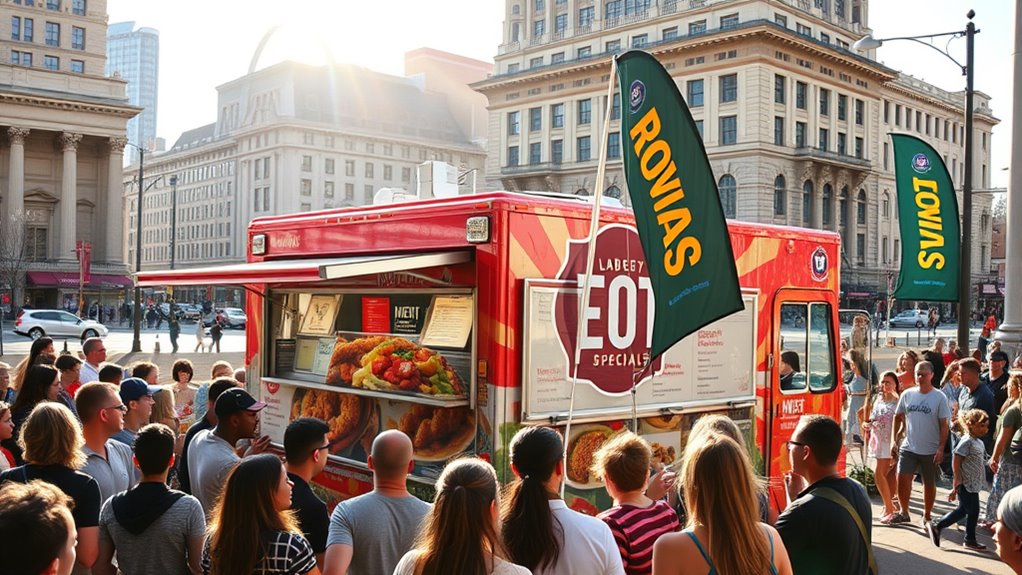
You can boost your food truck’s success by actively using social media platforms like Facebook to reach local customers and promote special offers. Participating in community events and festivals helps increase visibility and builds loyalty within the St. Louis area. Combining these strategies creates a powerful approach to attract new customers and keep them coming back. Additionally, leveraging effective marketing strategies can significantly enhance customer engagement and long-term success.
Leverage Social Media Platforms
How can a food truck maximize its reach and build strong customer relationships? By leveraging social media platforms strategically. First, focus on Facebook, which 75% of food trucks use for promotions and engagement. Second, utilize Instagram for eye-catching food photos and short videos to attract younger customers. Third, harness TikTok’s rising popularity—its 33% adoption recent growth led to 40% follower increases. Additionally, use Twitter for real-time updates and customer service, and YouTube for behind-the-scenes content and demos. To succeed, post high-quality visuals consistently, use targeted hashtags and location tags, and encourage user-generated content. Respond promptly to comments and messages, creating an authentic dialogue. Combining organic content with paid ads can appreciably boost visibility and foot traffic. Consistent posting across platforms ensures the audience remains engaged and aware of the food truck’s latest offerings and events. Incorporating relationship-building strategies like engaging with followers and responding to feedback can foster loyalty and repeat business.
Engage in Local Events
Participating in local events is a powerful way for food trucks to boost visibility and foster customer loyalty. In St. Louis, events like Sauce Food Truck Fridays at Tower Grove Park draw large crowds with live music and diverse cuisines. The St. Louis Street Food Festival offers a chance to showcase your menu at $5 or less per item, encouraging sampling and repeat visits. Parks in St. Charles provide regular opportunities to connect with families and build a steady customer base. Focus on popular times from May to September when multiple events happen. Partner early with organizers to secure spots, as capacity is limited. Participating consistently in these gatherings helps you establish a strong local presence, turning casual visitors into loyal customers. Additionally, Food Truck Friday events are held monthly, providing ongoing opportunities to engage with the community and expand your customer reach. To maximize your involvement, consider collaborating with local urban pursuits and community initiatives that align with your brand.
Tips for a Smooth Launch and Ongoing Operations
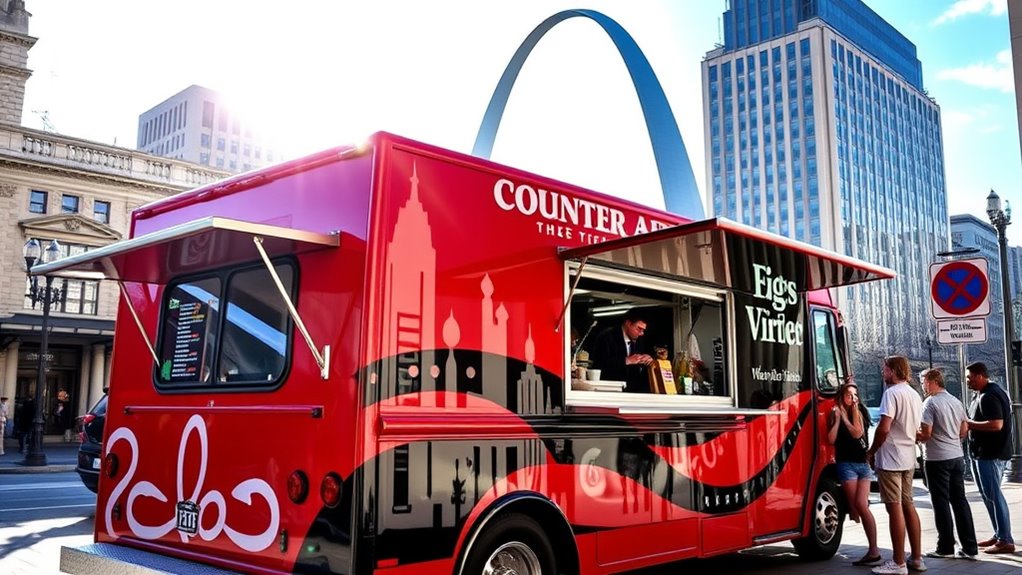
Launching and maintaining a successful food truck in St. Louis requires careful planning and ongoing effort. To guarantee a smooth launch and sustainable operations, focus on these key areas:
- Obtain all permits and licenses beforehand, including the Mobile Food Vending Permit and health inspection approval. Display permits clearly on your truck at all times.
- Choose strategic locations that maximize foot traffic while obeying zoning rules. Avoid restricted zones near schools or residential areas to prevent fines.
- Maintain high standards for food safety and sanitation by using a licensed commissary kitchen and keeping staff trained and certified. Regularly update your menu, marketing, and customer engagement strategies to stay competitive.
- Understanding local regulations and building good relationships with city officials can help prevent delays and ensure compliance as your business grows. Additionally, researching local food truck laws can provide insights into specific restrictions or allowances in different neighborhoods.
Frequently Asked Questions
How Long Does the Permit Approval Process Typically Take in St. Louis?
You’re probably wondering how long it takes to get your permit approved in St. Louis. Typically, standard vendor permits take 2-4 weeks, while food vendor permits need 3-6 weeks due to health inspections. Temporary permits are quicker, usually 1-2 weeks. To avoid delays, guarantee your application is complete, accurate, and all required documents are submitted promptly. Early application and proper preparation speed up the approval process.
Are There Any Specific Health or Safety Certifications Unique to St. Louis?
You should know that St. Louis requires specific health and safety certifications for food trucks. You need to get a Certified Food Manager (CFM) certification, approved by ANSI-CFP, and a Food Handler Card through an online course. Additionally, you must complete an annual fire safety inspection and obtain proper permits from city departments. These certifications guarantee you meet local health, fire safety, and operational standards, making your food truck compliant and safe.
What Are the Common Hidden Costs When Starting a Food Truck Business?
When starting a food truck, you often overlook hidden costs like permit and licensing fees, which can be thousands annually. You’ll also face unexpected expenses from vehicle maintenance, equipment repairs, and fluctuating inventory costs. Marketing, staffing, and weather-related contingencies add ongoing expenses. Plus, parking fines or zoning violations can surprise you, so budgeting for these hidden costs guarantees you’re financially prepared for the full scope of running your food truck.
Which Neighborhoods or Areas Have the Highest Demand for Food Trucks?
You’ll find the highest demand for food trucks in neighborhoods with lots of foot traffic, events, and entertainment options. Downtown and the Central Business District, Tower Grove Park, and Union Station attract crowds with festivals and tourists. University areas like WashU draw lunch crowds, while family-friendly spots like 9 Mile Garden offer outdoor dining. These areas provide steady, diverse customer bases hungry for multicultural and niche cuisines.
How Can I Effectively Differentiate My Food Truck Menu in a Competitive Market?
To effectively differentiate your food truck menu in a competitive market, focus on offering unique cuisine or signature dishes that set you apart. Use vivid descriptions and storytelling to create emotional connections. Incorporate seasonal and locally sourced ingredients to keep your menu fresh and relevant. Regularly update specials and limited-time offerings to entice repeat visits. Prioritize consistency and quality to build a loyal customer base that appreciates your distinct culinary approach.
Conclusion
Starting your food truck journey in St. Louis is like planting a seed in fertile ground—you’ll need permits, a tasty menu, and smart marketing to see it flourish. With careful planning and a splash of creativity, your truck can become a rolling feast that attracts hungry crowds and vibrant community connections. Keep your eyes on the horizon, stay compliant, and watch your culinary adventure bloom into a beloved local staple moving forward.
